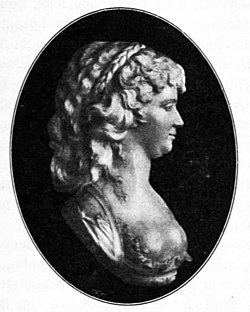Name Franziska Stading | ||
 | ||
Died February 8, 1836, Dresden, Germany | ||
Sofia "Franziska" (or "Francisca") Stading (1763 – 8 February 1836) was an opera singer and actor; originally from Germany, she became one of the most popular stars in Sweden in the 18th century. She was a court singer (Hovsångare) and a member of the Royal Swedish Academy of Music.
Biography
Franziska Stading was born in Berlin in Prussia in Germany as the stepchild of the musician Josef Hummel, (father of Johann Nepomuk Hummel), and seems to have grown up in The Hague in the Netherlands, where she was educated by Gertrud Elisabeth Mara and the pedagogue Graaf in music and singing.
In 1773, she arrived in Sweden at the age of ten together with her relative, the violinist F.B. Augusti, who became a member of the royal chapel and the husband of Lovisa Augusti. She was employed as a student at the Royal Swedish Opera in Bollhuset in Stockholm and made her stage début at Drottningholm Palace Theatre in the part of queen Myris in Arsene by Monsigny in 1779, when she was given a contract as premier actress.
She was called "beautiful, loveable and naive" as a person, and "charmfull and modest as an actor", and was admired for her realism, simplicity and artlesness, and the writer Marianne Ehrenström said about her that: "Her dark eyes could touch even a stone".
She played the main part in Cora och Alonzo by Naumann at the premier of the new building of the Opera in the 1782–83 season opposite Elisabeth Olin and Carl Stenborg, and Margareta Vasa in Gustav Vasa by Gustav III, the 19 January 1786, an opera called the greatest triumph of the Gustavian opera, regarded as her greatest part. Among her other parts where Myris in Arséne by Monsigny the 1779–80 year season, Sangaride in Atys by Piccini 1784–85 season, Andromache in Andromaque by Racine 1785–86, the goddess Frigga in Frigga by Gustav III, 1786–87, Elektra in Elektra by Johann Christian Friedrich Hæffner and Ebba Brahe in Gustav Adolf och Ebba Brahe (Gustav Adolf and Ebba Brahe) by Gustav III 1787–88, Ingrid in Folke Birgersson till Ringstad (Folke Birgersson of Ringstad) by Gustav III 1792–93, Charlotte in Renaud d'Ast by Dalayrac 1795–96, Antigone in Oidipus i Athen (Oidipus in Athens) by Sacchini 1800–01 opposite Christoffer Christian Karsten and Anais in Anakreon på Samos (Anachreon on Samos) by Gretry during the 1802–03 season.
In 1788, she was appointed court singer and elected into the Royal Swedish Academy of Music the 2 February (chair 107), the same year as Caroline Frederikke Müller and Lovisa Augusti. When Lovisa Augusti died in 1790, Stading and Caroline Müller was the leading prima donnas of the Opera in Stockholm and, as it was said, shared the main parts in the opera's performances between themselves. She was very popular; of all the idol-portraits printed of the singers at the Opera, she was the only one at the time to have images printed in three different variations at the same time.
In 1806, the Opera was closed (temporarily) by the king, and Stading retired with a full royal pension. She travelled to Germany, where she settled, and died in Dresden.
